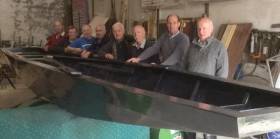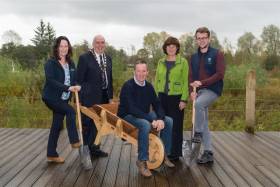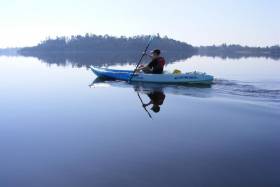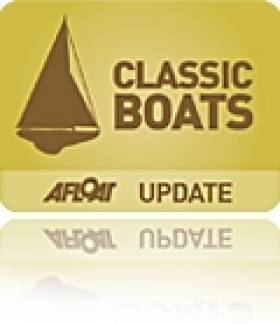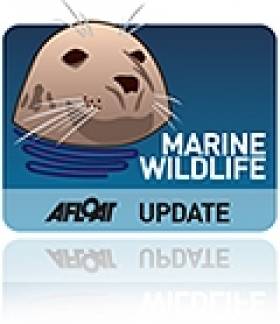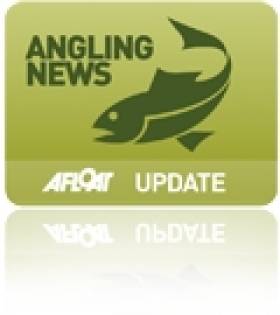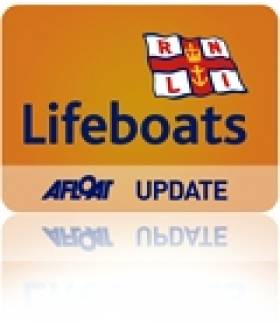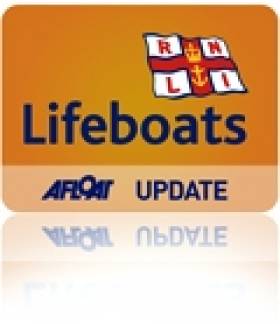Displaying items by tag: Fermanagh
Lough Erne Heritage Wins UK National Lottery Support For Programme To Preserve Area’s Boat Building History
A new community heritage project in Co Fermanagh focuses on raising awareness and preserving the heritage of traditional boat building and the cultural heritage of the people who lived on and around the shores of Lough Erne.
The ERNE Programme, which runs until June 2020, has been made possible by a UK National Lottery Heritage Fund award of £56,400 thanks to the money raised by lottery players.
This funding will help the programme establish a network of groups around Lough Erne, offer training opportunities for local volunteers to learn new skills, and develop a website with a ‘virtual museum’,
Other initiatives include interactive educational materials for schools, hosting Heritage in Action rowing regattas and an exhibition in June 2020 to showcase the heritage from around the inland waterway.
Welcoming the funding award, Gabriel Fitzpatrick, Lough Erne Heritage chair, said: “This project will enable local people to explore and share local history. We are pleased to have the opportunity to bring people together and tell the story.”
Jim McGreevy, of The National Lottery Heritage Fund’s NI committee, added: “We feel this project focusing on the strong boat building, rowing and associated heritage will complement our significant investment into the Lough Erne Landscape Partnership project.
“We’ve just launched our new five-year funding framework which outlines how we will continue to inspire, lead and resource the heritage sector.
“This new project is a great example of the projects we want to fund, it plans to explore important local heritage, involve a wider range of people in the project and to share everything that they uncover. We wish the project team well as they embark on their project.”
Formed in 2015, Lough Erne Heritage encourages research about Lough Erne, its traditional boats and the people who built and used them. In 2016, together with Cavan Town Men’s Shed, Lough Erne Heritage built two traditional Lough Erne Cots in order to demonstrate how they would have been used.
Handcrafted Tools Bring Royal Canal’s History to Life
#InlandWaters - Tools created by local Fermanagh craftsperson Albert Robinson were a key feature during this year’s World Canals Conference.
The tools, displayed in archive exhibition ‘Reflections, the Lasting Legacy of the Waterways’, brought to life the story of the strong men who powered the construction of Ireland’s canals system over 200 years ago.
Commissioned by the Directors General of Inland Navigation in 1813, the final section of the Royal Canal in Ireland to connect with the Shannon River was an extraordinary feat of ingenuity, engineering and sheer hard labour.
The contract to build the canal — complete with 21 locks, an aqueduct, 38 bridges, 40 tunnels, and numerous quays and harbours — was undertaken by Henry, Mullins and MacMahon in 1814 under the direction of the pre-eminent Irish engineer of that time, John Killaly.
Remarkably, that final section was completed within three short years at a cost of £198,110, covering a distance of some 24 1/2 miles.
What is most striking is that the tools available to the canal builders at this time, the world-famous ‘navvies’, were so basic.
Under the building contract, a detailed design specification was prepared for the manufacture of these tools to the company standard.
Local man Albert Robinson, a carpenter with Fermanagh and Omagh District Council, meticulously recreated these tools – a hand barrow and a wheelbarrow – using the specific wood types, elm for strength and ash for flexibility.
Patterson’s Spade Mills, owned and run by the National Trust, is the last remaining spade mill in daily use in Britain and Ireland. They, too, faithfully recreated objects from the original drawings, producing a spade and shovel.
The tools were on display throughout the World Canals Conference — which attracted over 320 delegates from 12 countries across three continents over its three days last month — and provoked much positive comment and requests for further displays of this quality work.
Commenting on the unique collection of handcrafted tools, Dawn Livingstone, chief executive of Waterways Ireland, said: “Working in partnership with Fermanagh & Omagh District Council and the National Trust, we have brought back to life a remarkable era of canal construction and created objects that tell the story of the men who built the amazing waterways that we continue to enjoy today.
“I commend the skill of the craftspeople involved from Fermanagh & Omagh District Council and Patterson's Spade Mill and would encourage visitors to see this extraordinary collection for themselves.”
Speaking about the exhibition, chairman of Fermanagh and Omagh District Council, Councillor Howard Thornton, said: “I am tremendously impressed by the craftsmanship shown by Albert in the recreation of the tools used in the construction of the final section of the Royal Canal.
“Albert’s ingenuity and craftsmanship have often been utilised in his work with Fermanagh and Omagh District Council and I am delighted that his talent has been showcased to a wider audience at such a prestigious event.”
Nathan Domer, visitor experience officer with the National Trust, added that “this type of project is at the forefront of our core aims as a charitable organisation to conserve our heritage on land and on water for all to enjoy for ever, for everyone."
The tools and the original blueprint drawings in the exhibition can be viewed at Waterways Ireland HQ at 2 Sligo Road, Enniskillen weekdays from 9.30am to 5.15pm till Friday 9 November.
#Sailability - Fermanagh and Omagh District Council, in partnership with Waterways Ireland, has organised an eight-week paddle sport programme commencing next Friday 4 August.
The free programme will enable young people with a disability aged eight to 16 to receive expert coaching in a range of paddle sports such as canoeing and stand-up paddleboarding. All necessary equipment will be provided.
Sessions from Friday 4 to Friday 25 August will take place in the Fermanagh Lakeland Forum’s swimming and commence at 8.30pm, while sessions from Saturday 2 to Saturday 23 September will commence at 1.30pm and be delivered on the open water at Castle Island in Enniskillen. Each session will last for 60 minutes.
Speaking about the programme, chair of Fermanagh and Omagh District Council, Councillor Stephen McCann, said: “The council is committed to creating more opportunities for our residents to get active so that they can enjoy the benefits of leading an active lifestyle.
“The paddle sport programme will provide water activity enthusiasts an opportunity to try different paddle sport activities through coaching and instruction from qualified coaches.”
Waterways Ireland chief executive Dawn Livingstone also spoke of her delight at partnering with Fermanagh and Omagh District Council to deliver a programme offering on the waterways activities for young people living with a disability.
“Waterways Ireland is actively growing the numbers of people enjoying sustained recreational opportunities to engage in water-based activity,” she said. “It is hoped that through the 8 week programme, young people will discover their favourite activity, something they continue to enjoy through life.”
Participation on the programme is free of charge, however places are limited and allocated on a first come, first served basis. Participants must be accompanied by a parent, guardian or carer for the duration of each session.
To register or for further information, visit Fermanagh and Omagh District Council’s website or contact Chris Elliott at +44 300 303 1777 or [email protected].
Wooden Boat Building In Fermanagh: Keeping The History Alive
#HistoricBoats - The storied tradition of wooden boat building in Fermanagh is the subject of a new exhibition at Enniskillen Library from next Monday 29 June to Saturday 4 July.
Photos, anecdotes and artefacts of the era of clinker-built boats and cots before the advent of fibreglass will be on display at the library each day between 10am and 4pm.
And organisers with Lough Erne Heritage are also looking to gather information from local people, many of whom still have valuable old-school boatbuilding knowledge, that could tell us even more about those bygone days.
Stories, photographs, cine film and images of original boats and related artefacts such as hand tools and early outboard engines - if you have them, bring them along for recording in the collection.
Picturesque Homes In Clare & Fermanagh Perfect For Anglers
#WaterfrontProperty - Two new properties on the market in Clare and Fermanagh are sure to appeal to keen anglers.
Sugarloaf on Clifden Hill in Co Clare overlooks Lake Inchiquin, described by the Irish Independent as an 'angler's paradise', and hosting a bounty of wildlife including the spectacular sea eagle.
But the picturesque spot is also a popular area for sunny-day picnics, and not only with the locals.
Sugarloaf provides a permanent picnic spot in the heart of that beautiful visa, with a detached three-bed home in 1.5 acres of gardens with panoramic views of the lake nearby and the Burren beyond.
And in spite of its privacy, with no neighbours in sight, you're just 3.5km from the village of Corofin and a swift drive further on to Ennis.
The Irish Independent has more on this property, on the market for €315,000.
North of the border, angling enthusiasts might be tempted by Amled's Fishing Lodge in Garrison, Co Fermanagh.
Within walking distance of Lough Melvin, the spacious detached five-bed home is on a secure site with high fencing, and plenty of room for boats and more in the driveway.
The wooded grounds have also been developed by the previous owner for wheelchair use, making garden maintenance easier than usual.
It's an unfinished renovation project - the upstairs is yet to be completed - but it'll be more than worth the effort to many, especially with an asking price of just £115,000 (€159,000). 4NI has more on this property.
Elsewhere, for those who just want to enjoy that seaside vibe, the Irish Independent sings the praises of Salthill in Galway.
Just a short walk from the centre of the City of the Tribes, the charming suburb maintains its own old-school seaside town atmosphere, with plenty of local social options, especially for dining.
And of course there's the renowned promenade, which hosts among others the annual An Tóstal race for Galway Hookers.
Sea Eagle Remains Found In Fermanagh
#MarineWildlife - "A sad end to a beautiful bird" is how the Golden Eagle Trust described the news that remains of a white-tailed eagle were found near Lower Lough Erne in Co Fermanagh earlier this month.
As RTÉ News reports, Ingar was released in Killarney National Park in 2011 as part of a reintroduction programme for the species, also known as the sea eagle.
That same programme saw the introduction of Ireland's first breeding pair of white-tailed eagles in over a century.
Saoirse and Caimin reared their first chicks in 2013, and the birds of prey have proven very popular in Lough Derg, where they relocated from Killarney in 2011.
Ingar's GPS transmitter showed that he had flown to different climes further north, spending the majority of last year on Lough Erne - though it stopped transmitting in December.
#Angling - The 2014 Waterways Ireland Classic Fishing Festival came to an exciting close as local angler John Potters emerged victorious with a total catch over three days of 49.45kg.
His 16.8kg catch on the final day clinched him the Classic title for 2014, along with a cheque for £5,000 (€6,180) and the coveted crystal chalice.
Potters' achievement is all the more remarkable as he is the first angler in the 39-year history of the classic to win the event for a second time, having previously won in 2011.
Close behind in second place was Kevin Rowles from Wiltshire, whose day-three catch on Boa Island boosted his total to 46.94kg, earning him £2,000 (€2,470) and a crystal trophy.
In third place was Brenton Sweeney from Cootehill, with a total of 44.05kg, which netted him £1,500 (€1,850) and a trophy.
In fourth overall was Matthew Hall from Nottingham with 43.77kg; Phil Bardell from Milton Keynes was fifth, and Cootehill angler Neil Mazurek completed the leaderboard in sixth place.
Organisers of the 2014 Waterways Ireland Classic said they were very encouraged by the increase in the number of anglers who entered the competition and by the fact that the average catch per angler showed a 2kg increase over last year.
The Classic Fishing Festival was sponsored for the 12th year by Waterways Ireland, with additional sponsorship from DAIWA, and was organised by Fermanagh District Council in conjunction with the Inland Fisheries Division of the Department of Culture, Arts and Leisure.
New Rowing Course to be Built by Fermanagh and Hungarian Firms
#RowingCourse: Deane Public Works from Fermanagh will be awarded the main construction contract for the new rowing course at Lough Rynn in County Leitrim. The specialist work of design, supply and installation of the lanes will sub-contracted to Polaritas, a company from Budapest in Hungary. According to Leitrim County Council, the company have worked on the rowing courses for the 2008 and 2012 Olympic Games and will work on the installation of the rowing course for the Olympic Games in Rio de Janeiro in 2016.
The design/build contract for Lough Rynn involves the design, supply and installation of an eight-lane Albano Rowing Course to meet FISA (Fédération Internationale des Sociétés d’Aviron) Standards. The course will also be adjustable to meet canoe sprint competition rules of the International Canoe Federation.
The course may be finished by the end of this year.
#RNLI - Enniskillen RNLI will host the revived Castle Island charity swim and family fun morning in Enniskillen, Co Fermanagh on Sunday 11 August.
The swim traditionally took place each year with the support of the Blake family.
And Enniskillen RNLI have hailed as a "great honour" the opportunity for its local volunteer crew to revive the swim in association with sponsors Blakes the Hollow, Western Cars and The Print Factory.
The 750m swim on Lough Erne is open to swimmers of all ages either individually or in small groups such as youth clubs, sports clubs or simply groups of friends.
Enniskillen RNLI says the emphasis for this swim is for everyone to have fun and for that reason, if required, novice swimmers may complete the swim in a well-fitted lifejacket or buoyancy aid but must be confident that they can complete the distance.
Lifeboat crew not swimming themselves will also be present on the day to provide safety cover for the event.
Registration for the swim will take place at 12 noon on the day, followed by a short safety briefing. Sponsorship forms are available by email or can be collected at The Wig & Crown, Blakes the Hollow and Western Cars. For further information contact Adrian at 07974 730456.
In other news, RTÉ Radio 1’s The Business will broadcast live from Bundoran RNLI lifeboat station this Saturday morning 3 August.
The focus of the show will be on the business of Bundoran being a seaside resort - a reputation the Donegal town has enjoyed for more than two centuries.
Speaking ahead of his visit, programme host George Lee said: "I'm really looking forward to broadcasting from Bundoran, particularly on a bank holiday weekend. I'm hoping to experience lots of surfing, slots machines and ice-creams.
"On the show we'll be looking back at the heyday of the dancehalls, we'll be joined by Bundoran regular Ramona Nicholas from Dragon's Den, we'll be speaking to two men making money from oil exploration and lots, lots more."
The Business is broadcast Saturday morning at 10am on RTÉ Radio 1.
#RNLI - Enniskillen RNLI today (10 June) brought four people to safety in two separate incidents on Lough Erne in Co Fermanagh.
In the first call-out of the day, the volunteer lifeboat crew retrieved a man and women from their stranded cruiser which had developed engine problems and run aground on Lower Lough Erne.
The inshore lifeboat Joseph and Mary Hiley and the Rescue Water Craft (RWC) were launched just before 10am at the request of Belfast Coastguard and made the 25-minute, six-mile journey to the casualty's last known position at Crunnish Island. The wind was coming from the south east, force five with good visibility.
On arrival at the scene, the crew noted the casualties had deployed their anchor and there were strong waves hitting the starboard side of the vessel.
The RWC crew member was transferred to the casualty vessel to reassure the crew and to check for any leakage. Another crew member from the lifeboat was transferred to assist with the tow and to lift the anchor.
The lifeboat established a tow and the vessel was refloated and brought to safety at Tudor Farm jetty, close to the initial location.
Less than three hours later, the inshore lifeboat Jason Logg was launched by request of Belfast Coastguard to rescue two people on a broken-down personal water craft on Upper Lough Erne.
The crew proceeded to the casualty's last known whereabouts at the mouth of Tamlagh Bay, four miles downstream from the station towards Enniskillen.
On arrival, the crew found the troubled vessel in the reeds with two people sitting on it. The crew transferred both passengers onto the lifeboat before setting up a tow and bringing the water craft back to Bellanaleck Marina.
Elsewhere in Northern Ireland, Portaferry RNLI brought three men and a teenage boy to safety yesterday afternoon after their yacht got into difficulty off Portaferry in Co Down.
The volunteer lifeboat crew was alerted just after noon following a mayday call that there was a demasted yacht in trouble on Strangford Lough.
The lifeboat was launched minutes later and was alongside the stricken vessel, a 37ft yacht located in the narrows of Strangford Lough, at 12.10pm. Weather at the time was good with clear visibility and a flat calm sea.
One of the four casualties, who had been thrown from the vessel, had been recovered by a fellow crew member and all four were on board the yacht when the lifeboat crew arrived on scene.
Alongside, there was difficulty recovering the vessel so the mast and sail were cut away. Once cut, the lifeboat proceeded to tow the yacht with it crew on board safely back to Strangford where it was tied to a mooring.
Two of the crew were conveyed to hospital while the other two were made comfortable on the shore.
Portaferry RNLI was requested to launch for a second time later this afternoon following a report that a swimmer had gone missing in Newtownards. The lifeboat having launched was subsequently stood down after the missing person was found safe and well.


























